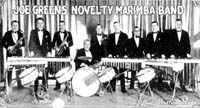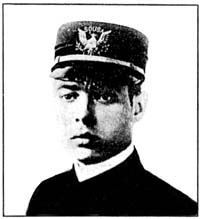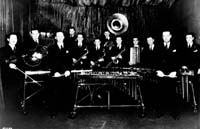Green Brothers Novelty Marimba Orchestra/Band
The oldest of the Green brothers, Joseph Peter, was born in Omaha, Nebraska on February 9, 1892, fifteen months before his more famous younger brother, George Hamilton Green. He died on October 16, 1939, at the age of 47.
Joseph not only played the xylophone, but (unlike George) he was also an excellent drummer. He studied with timpanist Joseph Zettelman of the Chicago Symphony. Joe’s early career included stints with Sousa’s band and with the Victor Talking Machine Company as a sessions man.
The Green brothers co-led their own groups, which all featured the two brothers playing xylophones and other percussive instruments. In addition to their appearances and recordings as the Green Brothers Novelty Marimba Orchestra/Band, they also recorded in the United States as Joe Green’s Novelty Orchestra (Edison Diamond Disc), The Blue and White Marimba Band, Klein’s Serenading Shoemakers, Joe Green’s International Novelty Orchestra (Victor). In Canada they recorded as Joe Green’s Ambassadors (Melotone), Joe Green’s Continental Marimba Band, Joe Green’s Marimba Band, Joe Green’s Royal Orchestra, and Joe Green’s Vibraphone Dance Orchestra.
- The Green Brothers’ Novelty Orchestra in an unidentified New York recording studio (c. 1930-31).
From the New Amberola Graphic No. 81 (July 1992). Gerhardt Collection - Photo courtesy James A. Strain
- George H. and Joe Green, with the Castlewood Marimba Band. Instruments by Leedy.
 Leedy Drum Topics No. 14 (April 1927). Gerhardt Collection
Leedy Drum Topics No. 14 (April 1927). Gerhardt Collection Joseph Green in his Sousa band uniform. Photo courtesy James A. Strain
Joseph Green in his Sousa band uniform. Photo courtesy James A. Strain
William L. Cahn notes that personnel and instrumentation on the recordings produced by the Green Brothers Novelty Marimba Band were never constant. He identifies the personnel typically appearing on their early recordings as George Hamilton Green and Joseph Green (xylophone/marimba/vibes/drums); Earl Oliver, Hymie Farberman, and Harry Glantz (trumpet); Tom Brown and Charles Randall (trombone); F. Wheeler Wadsworth, Rudy Wiedoeft, and Sammy Feinsmith (also saxophone); Ed Violinsky (violin); Victor Arden and Phil Ohman (piano). Beginning in 1928, the youngest Green brother, Lewis, joined his older brothers’ various ensembles on guitar and banjo.
The father of the musical Green family in Omaha, Nebraska, was coronet player and bandmaster George Green, Sr. Over the course of a thirty-one year career, his band played for four Presidents – Cleveland, McKinley, Roosevelt, and Taft. His father, Joseph, was also a bandmaster.
Cincinatti’s Musical Messenger for June 1919 describes George Sr. as a man who “takes great satisfaction in the character and reputation of his boys, and justly so. When they made known to him that they desired to be musicians he said to them: ‘If you intend to be musicians, be good ones or none at all.’ They accepted the challenge, worked hard, against odds at times, but soon attained an eminence in their profession that justifies their fondest dreams. Father Green was not a man of opulence, but optimistic as to the outcome of his boys’ ambitions. He sacrificed and endured hardships that his boys might have every advantage possible to them in the acquirement of a musical education, they denying themselves likewise in the pursuit. Their place now among musicians has fully repaid him for all his anxiety and self-denials. He hears of their popularity and successes and listens to their playing on the phonograph records.”
George Green Sr.’s youngest son, Lewis, joined his well-established brothers’ ensembles in 1928, long after the cylinder recordings in the Gerhardt Collection were made. Like his brother, George Hamilton, Lewis was also a gifted a visual artist. He joined the Fleischer studio in 1929 as an animator, working on Ko-Ko the Clown. He also did the cartoon “Mike Sketches” which was syndicated until 1935. The first three Disney films (“Steamboat Willie,” “The Opry House” and “Skeleton Dance”) all used Green Brothers music. In the 1930s, Lew Green was accompanist for Kate Smith, appearing with her in the movie “The Big Broadcast of 1932.” As a cinematographer for the Chicago Bears, Lew filmed game action for later viewing by coaches and players. He became one of the first producers of televised NFL games, including the home games of the Chicago Bears and Chicago Cardinals. Lewis G. Green died on June 14, 1992 at the age of 82.
This information is taken from William Cahn, The Xylophone in Acoustic Recordings (1877 to 1929). Bloomfield, NY: Cahn Publishing, 1996, and other sources collected by Edwin Gerhardt.












